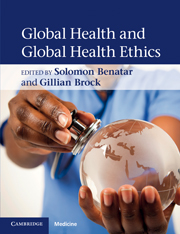Book contents
- Frontmatter
- Contents
- List of contributors
- Introduction
- Section 1 Global health, definitions and descriptions
- 1 What is global health?
- 2 The state of global health in a radically unequal world: patterns and prospects
- 3 Addressing the societal determinants of health: the key global health ethics imperative of our times
- 4 Gender and global health: inequality and differences
- 5 Health systems and health
- Section 2 Global health ethics, responsibilities and justice: some central issues
- Section 3 Analyzing some reasons for poor health
- Section 4 Shaping the future
- Index
- References
2 - The state of global health in a radically unequal world: patterns and prospects
Published online by Cambridge University Press: 01 March 2011
- Frontmatter
- Contents
- List of contributors
- Introduction
- Section 1 Global health, definitions and descriptions
- 1 What is global health?
- 2 The state of global health in a radically unequal world: patterns and prospects
- 3 Addressing the societal determinants of health: the key global health ethics imperative of our times
- 4 Gender and global health: inequality and differences
- 5 Health systems and health
- Section 2 Global health ethics, responsibilities and justice: some central issues
- Section 3 Analyzing some reasons for poor health
- Section 4 Shaping the future
- Index
- References
Summary
Introduction
Sir Michael Marmot, who chaired the World Health Organization (WHO) Commission on Social Determinants of Health, has identified the need to seek “public policy based on a vision of the world where people matter and social justice is paramount” (Marmot, 2005, p. 1099). In this chapter, we ground this imperative in evidence of dramatic disparities in health status that are traceable, in large measure, to the globally unequal distribution of resources necessary for health. We further outline the contours of an international economic and political order that often magnifies those inequalities, and conclude that the imperative of mobilizing resources to protect health on a much larger scale than at present is central to any global health ethics worthy of the name.
“If living were a thing that money could buy”
Imagine for a moment a series of disasters that killed almost 1400 women every day for a year: the equivalent of four or five daily crashes of crowded long-distance airliners. There is little question that such a situation would quickly be regarded as a humanitarian emergency, as the stuff of headlines, especially if ways of preventing the events were well known and widely practised in some parts of the world. However, remarkably little attention is paid outside the global health and human rights domains to complications of pregnancy and childbirth that kill more than 500,000 women every year – a cause of death now almost unheard-of in high-income countries (HICs).
- Type
- Chapter
- Information
- Global Health and Global Health Ethics , pp. 24 - 36Publisher: Cambridge University PressPrint publication year: 2011
References
- 11
- Cited by

